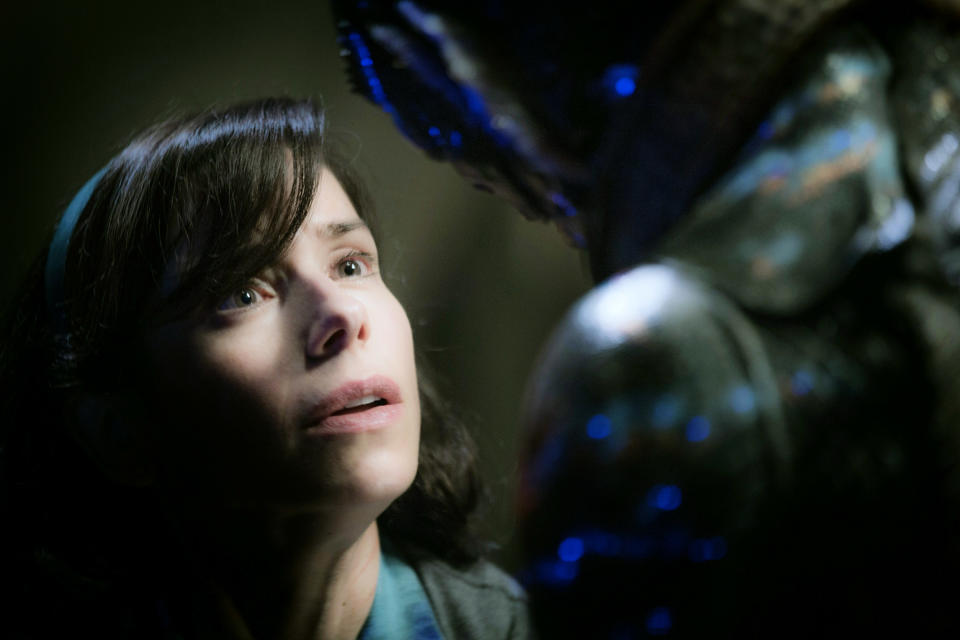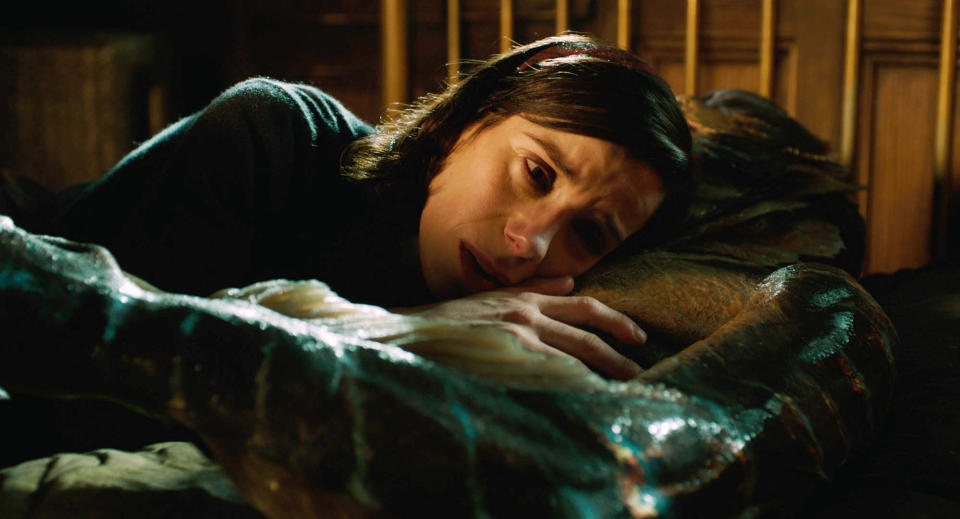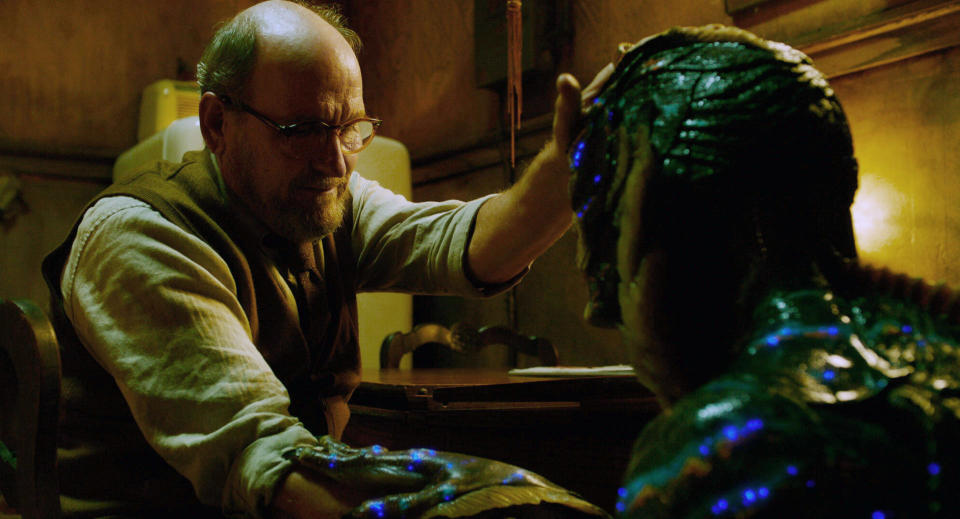How to make a sexy sea monster and other 'Shape of Water' secrets revealed! (exclusive)
Guillermo del Toro’s romantic fairy tale The Shape of Water represents a breakthrough in human-fish relations. That’s not just because this lovingly crafted homage to classic ’50s creature features is up for 13 Oscars at this year’s Academy Awards, including Best Director and Best Picture. It also pushes the envelope well past love stories like Splash and The Little Mermaid, where men and mermaids enjoyed relatively chaste romances. In contrast, The Shape of Water’s lovers — mute janitor Elisa (Sally Hawkins, a Best Actress nominee) and a South American river god (Doug Jones) — get hot and heavy during the course of the film, instantly making them one of the most memorable interspecies couples in movie history.
Del Toro recognized early on in the production process that his love story hinged on audiences finding the Fish-Man as attractive as Elisa does. So he devoted more than a year — and hundreds of thousands of dollars of his own funds — toward sculpting a version of the creature that was, to put it bluntly, a total stud. “It needed to be very attractive, a creature you could fall in love with,” the director remarks in this exclusive behind-the-scenes clip that Yahoo Entertainment is premiering today. (Watch the video above.) Del Toro handed off that challenge to top creature designer Mike Hill of Legacy Effects, who built a suit for Jones that was further enhanced in postproduction by Dennis Berardi, head of the visual effects company Mr. X, which oversaw the effects work for The Shape of Water.

The technique was pure hybrid,” Berardi explains to Yahoo Entertainment in a separate interview. “Generally speaking, when you see the body and head movements of the Fish-Man — or the asset, as we called him — that’s Doug Jones in a suit. But whenever you see him under water, then he’s animated. I would also say that every single shot where you have the creature onscreen, the eyes and brow area are digital, because the way the mask worked, the eyes were a thick resin plug that didn’t articulate. Our methodology was to work from the eyes out, preserving as much of Doug’s performance as possible. But every single shot has varying degrees of visual effects in it, from micro-expressions like eye blinks to full-body animation.”
Unfortunately for Berardi, visual effects was one of the few Oscar categories in which The Shape of Water missed out on a nomination, with nods instead going to Blade Runner 2049, Guardians of the Galaxy, Vol. 2, Kong: Skull Island, Star Wars: The Last Jedi, and War for the Planet of the Apes. But he and his team absolutely share a role in the movie’s success, infusing the creature’s costume design (which is up for an Oscar) with additional life. Having collaborated with del Toro on both Pacific Rim and Crimson Peak, Berardi has regularly enjoyed a front-row seat to the director’s creative process. Read on for additional trade secrets behind The Shape of Water and its strapping Fish-Man.
It started with a sketch.
Berardi’s first glimpse of The Shape of Water‘s aquatic heartthrob was as a two-dimensional sketch in one of the notebooks that del Toro always has on hand to jot down ideas and images as they pop into his brain. (Some of those notebooks have been published in anthology collections.) “He showed me a sketch of their embrace,” the effects supervisor remembers, referring to an early version of the clinch between Elisa and the “asset” that appears on the movie’s poster. “It was such a romantic image, and he told me, ‘This is a movie that’s in love with love.’ You had a creature that had to be a leading man that Elisa had to fall in love with and that the audience had to fall in love with. He told us right at the beginning that this wasn’t a monster — it’s an intelligent being with a soul, and eyes that had to be soulful and deep.”
The creature also had to be a top-notch swimmer whose movements read as pure poetry in the water. To aid with that, Berardi had his team study Olympians like Michael Phelps as a starting point. “Those guys are powerful and swim somewhat gracefully, but nothing as graceful as what Guillermo really wanted. So then we looked at dolphins, sea lions, otters, and seals and settled on this hybrid of a humanoid swimming, with a bit of a dolphin kick. Seals actually became a lot of inspiration as well, because they move slipstream through the water very gracefully.”
Junk in the trunk
In one of The Shape of Water‘s standout sequences, Elisa and her lover consummate their powerful attraction in a bathroom that she transforms into a makeshift water tank. It’s an erotically charged moment and del Toro takes full advantage of his R-rating, allowing the two to see, and touch, each other’s naked bodies like any Homo sapien couple would. Boundary-pushing as this scene may be, it stops just short of the final frontier: merman genitalia. And that’s just fine for Berardi, who would have been responsible for helping imagine what the creature’s junk might look like. “Guillermo’s got too much taste for that,” Berardi remarks with a laugh, pointing out that Elisa and her friend Zelda (Octavia Spencer) instead discuss her lover’s size after their intimate encounter. “His inspiration for the movie was when he was 6 years old watching Creature From the Black Lagoon and hoping that the creature gets the girl.”
That’s a note that del Toro passed along to Hill as well. “This thing has to be attractive to a woman,” the creature designer remarks in the above clip. “My directive was that I wanted to make him handsome.” For his part, Jones clearly appreciated the matinee idol physique that Hill crafted for his aquatic alter ego. “My lips are a little fuller, there’s a strong jawline, and the body they sculpted on me is very athletic. He’s handsome in a fishlike way.”

The shape of (digital) water
If the Fish-Man was a hybrid of practical and digital effects, the water he calls home is almost entirely digital with one notable exception — the aforementioned love scene in Elisa’s bathroom. “That’s the only scene where we had the actors in water, ever,” Berardi reveals. “We had a water tank that we built and submerged the bathroom set, with the actors, in the tank. It was done in such a safe way that they could just be hovering around the surface with footholds and handholds. They’d film for 20 or 30 seconds and then come back up easily because the water level was just above their heads. Sally and Doug were both game.” Everywhere else, though, the H20 was all CGI, and even with all the advancements that have been made since The Perfect Storm — the movie that Berardi cites as a breakthrough for digital water effects — simulating water is still one of the most difficult jobs for an effects house.
Interestingly, the most challenging shot involved another tank of sorts, the iron lung capsule that serves as the creature’s prison as he’s transported from South America to the Baltimore research facility where the film’s events unfold. “There was no water in that capsule,” Berardi says. “It would have been way too unsafe to have Doug in there. But we had to see water sloshing around through the glass while the asset is in there. The creature also had to slam his hand on the glass, so his digital hand would have to come through the digital water and hit the glass. All of that is 3D and volumetrically rendered. That was the shot that kept me up at night.”

Here kitty, kitty
Cat fanciers will be happy to hear that no real felines were harmed in the making of The Shape of Water. The same can’t be said for the computer-generated cat that the creature chows down on while hiding out with Elisa and her friend Giles (Richard Jenkins). And the Fish-Man is a messy eater too, getting blood all over the floor and himself. That may sound like a big turnoff, but del Toro felt it was crucial to showcase his hero in his less glamorous moments. “Guillermo didn’t want to make a traditional Beauty and the Beast-type story where the beast can’t really be himself. He’s eloquent, strong, and heroic, yes, but he also needs protein!”
For the first part of the scene, Jones worked with an on-set cat wrangler to provoke a flesh-and-blood feline into a hissing fit. When the time came for the creature to open the cat’s head like a Pez dispenser, Berardi’s team took over. “We put a green sock puppet in Doug’s hands, replaced that with a digital cat and then severed the head. We went through about 25 iterations about what the cross section of the neck needed to look like and showed Guillermo the grossest ones we could devise — anatomically correct with the spinal cord, nerve endings, and all that stuff. We totally went there with it. That was also a moment when we took over Doug’s head and did it digitally: We fluttered the gills and had water spray off of them. That was probably one of the most fun things for us to animate.”
The Shape of Water is currently playing in theaters and available on digital. The film arrives on 4K, Blu-ray, and DVD on March 13.
Read more from Yahoo Entertainment:


